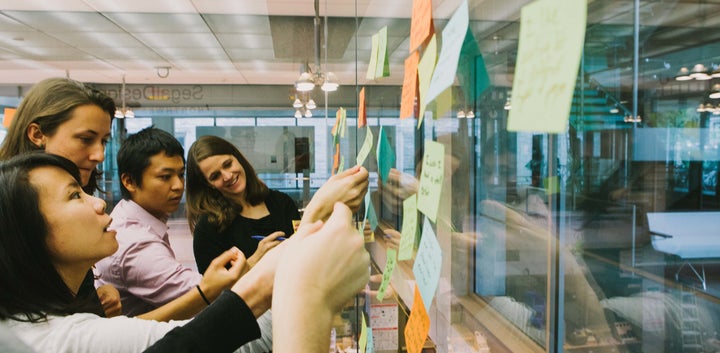
Today’s workplace calls for a new style of leadership to embolden and accelerate innovation. Design Thinking offers a novel way of discovering opportunities in the marketplace, generate better ideas with your team, and quickly learn what works and doesn’t work.
There are 4 essential mindsets to Design Thinking:
Work together. Important problems worth solving are often situated in complex systems which involve many stakeholders. To design sustainable, useful, and meaningful solutions, understanding and integrating different perspectives is imperative. Dr. Teresa Amabile finds that for truly complex problems, it’s not enough to depend on a single expert with a single perspective. Innovation occurs at the intersection of existing fields. When people with diverse backgrounds get together, you can more quickly get to novel insights and solutions. As an example, when the Erie Community Health Clinic was working on a new online medical health record system, the design team included a medical doctor, a social worker, a patient, a care giver, and technician who maintained the website. In everything from design research to idea generation to user testing, it’s vital to work together.
Build to learn, not to impress. Learning and innovation are tightly linked. We learn more when we focus on what is possible rather than be pre-occupied with appearing to have all of the answers. This mindset is based on Dr. Carol Dweck’s twenty years of research on fixed and growth mindsets. Dr. Dweck finds that people who believe intelligence is a matter of genetics, will avoid failure at all costs. They strive to be right believing it will make them competent. However, striving to impress others causes people to do what they know rather than explore what they don’t know. By contrast, people who have a growth mindset, are constantly seeking learning opportunities. They are driven by the belief that you can always learn more and improve through practice. Failed attempts are not a sign of inadequacy and risks are happily taken. As an example, the Erie Community Health Clinic built many rough inexpensive mock-ups out of paper and cardboard to understand how to improve health care. Their exploration included understanding the necessary size of the electrical medical record interface, placement of the monitor in the exam room, and sequence for data entry, and so on. The team focused on the direct, actionable feedback elicited from the mock-ups to enable learning rather than the avoidance of dead-ends.
Take many paths is based on research that when we commit to a single idea early, we are less likely to learn. Throughout the course of a project, learning from mistakes tends to be more costly. Good and bad ideas expose important gaps in knowledge and we are better at comparing between many options rather than providing an absolute judgment. Management researcher Dr. Steven Thompke, finds that systematic testing of ideas enables organizations to learn whether ideas have promise. As an example, when creating the medical record system, the team aimed to create at least three different mock-ups at each stage of the design process so that they would not fixate on a single solution, but rather keep in a state of exploration.
Embrace change is based on research that finds that innovators actively desire to change the status quo and regularly take risks to make the change happen. Steve Jobs talked about “putting a ding in the universe,” Skype cofounder Niklas Zennström “being disruptive, but in the cause of making the world a better place” and Jeff Bezos wants to “make history.” They avoid the human tendency to prefer the existing state of affairs to alternative one. My own research found that it was easier to take risks and learn from mistakes when embracing design innovation’s mission of embracing change. The interdisciplinary design team described in the previous examples, had a vision to transform health care and knew that their unflinching willingness to taking risks and learning from mistakes was the only way to get there.
While these mindsets are easy to say, they can be hard to foster in a work environment where people are busy with their current work and resistant to change. People have the tendency to worry that those watching are evaluating their performance. They feel unsafe when learning from experimentation. And they perceived prolific experimentation as expensive (requiring time and effort) and threatening to their job security.
Great leaders provide inspiration to follow these mindsets by setting an inspired vision for the organization’s future when following these mindsets. They set clear boundaries making it easier for people to take risks. They provide opportunities to grow in these mindsets. But most importantly, leaders lead by example.
Design thinking approach can be used to design your own organization and in doing so, you can be a role model to your employees. So your challenge as a leader of innovation is as follows: How might you design your human resource strategy? Your hiring approach? Your jobs? Build your team? Arrange your physical space? And more.
Thank you to Northwestern University and Coursera for allowing me to develop these ideas through a Massive Open Online Course: Leadership Through Design Innovation.
